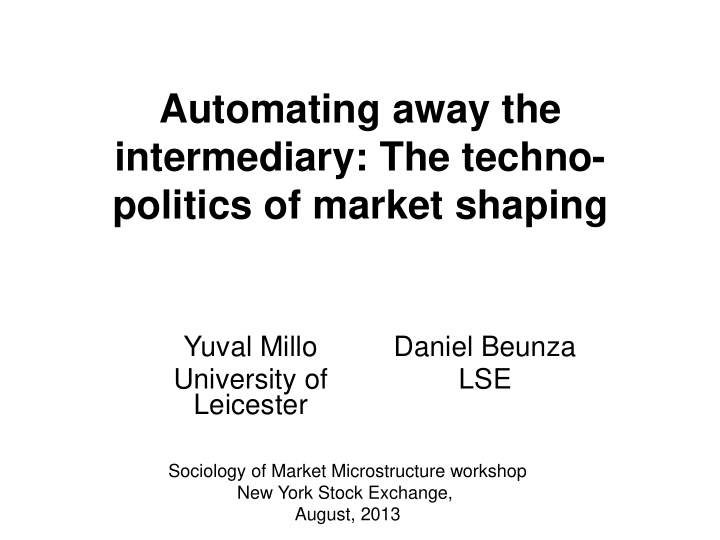



Automating away the intermediary: The techno- politics of market shaping Yuval Millo Daniel Beunza University of LSE Leicester Sociology of Market Microstructure workshop New York Stock Exchange, August, 2013
Research question • Economists: automated financial exchanges are believed to provide low transaction costs and fast execution times and therefore are considered cheaper and more efficient (Jain 2005: 2958). • Sociologists: market design also reflects ideologies/agendas (Quinn, 2008; Poon, 2013). • We ask: given these differences, how to explain the automation of exchanges?
Methods: historical sociology • Rationale: Automation of exchanges as a process where regulators are deeply involved – The main regulator in this case is the SEC – SEC applies a policy of requests for comments. – Series of 'public experiments‘ (Collins, 1988; Collins & Evans, 2002) • Analysis of primary documents: 1968-2007 releases by the SEC, comment letters, transcripts of Congressional Hearings • Oral history: interviews with leading actors – SEC chief economists, heads of divisions – Heads of AMEX, NASDAQ, executives in NYSE
Findings • Market automation is a 'three- legged stool‘. Regulatory vision was strengthened by economic theory and was realised by information technology (but also cross- directional). Techno-politics (Mitchell, 2002). • Interaction between worldviews and technological capabilities, not organisational assimilation (Fligstein meets Latour?) • Regulators promoted a vision of inclusive, democratic markets, where the principals control the trading process, not the intermediaries. • The initiative, however, ended up enriching the ‘big players’ (who control automation) and contributed to more fragmented less transparent markets.
Automating order matching • SEC’s Institutional Investor study (1969 -1971) • Testimony before a Congressional committee, Donald Feuerstein Chief Counsel of the Institutional Investor Study: “My general view is that all secondary trading in equity securities should ultimately take place in a single computerized market supplemented by telephone communication. To avoid unnecessary cost to the public, dealer participation in that system should be discouraged when it does not result in better prices for investors.” (Testimony of Donald Feuerstein, p. 2957) • But, at the time, no such market existed, nor was the technology available..
Automating order matching • Seymour Smidt, professor of managerial economics in Cornell University: “The computerized system I have in mind would be analogous to the present auction market. […]Orders would be transmitted to an exchange floor. There, they would be inserted into the memory of a computer. The computer's memory serves as the specialist's book. Each competing market maker would have equal access to the contents of the book. Market orders would be automatically executed against the best available bid or offer.” (Congressional hearings, 1972, p. 3462)
The market as a database • Fischer Black (1971): financial markets as ‘price discovery’ systems that are reducible to electronic networks of principals linked by cables, leading to a “thinking whole”.
Gradual setting of automated inter- exchange network • 1972 – central limit order book (CLOB) proposed • 1972 – 1974 - National Market Advisory Board and Office of Economic Analysis set up: both populated by economists who support the intermediaries-free market idea.
Gradual setting of automated inter- exchange network (cont.) • 1974 - Consolidated Tape Association that aggregated and recorded trades • 1975 – CLOB concept included in amendments to SEC’s rules • 1978-1980 - calculation of the national best bid or offer, Inter-market Trading System • 1982-1985 – Rules requiring market makers to reveal customer orders
Scepticism about human intermediaries • October 1987 - NASDAQ market makers refrained from ‘taking the other side’ during price-volatile periods • Early 1990s – paper in 1994 indicated that market makers colluded in avoiding quoting in odd eighths • 1996 - Limit Order Display Rule: specialists to display publicly customer limit orders that improve the specialist’s displayed price or size.
Displacing the humans: The rise of ECNs • Limit Order Display Rule made available stream of orders and now brokers could ‘cross’ orders internally, without using the exchanges. • Brokers who preformed the crossings, automatically, became known as Electronic Communication networks. • ECNs provided very little information to the trading public (only executed prices were reported) • The ancestors of today’s dark pools
Displacing the humans: algorithmic order generation • Computer terminals on the floors of the exchanges motivated brokers, initially, to replace manual typing with pre-programmed • This developed to more set of orders. sophisticated trading algorithms, which undermined the roles of brokers and market makers (including HFT).
The human ‘bottle neck’ • 1996-1997 NASDAQ and ECNs: systems cannot be programmed so as to wait for manual execution in other exchanges. • Opted out of the Inter-market Trading System • 2000 – Market modernization Act: orders need to be displayed ahead of execution.
Displacing the humans: order display times • 2004 - Proposal: orders to be displayed for 30 seconds, allowing potential buyers/sellers to interact. • But, the Lawrence Harris (SEC chief economist) argued, would amount to free ‘look back option’ on the stock: during the 30 seconds one could decide if to buy or not. • 2005 - Final rule: a reaction time of one second for all intermediaries • Human floor intermediaries are out of the game!
Discussion • Financial markets are arenas where a regulatory vision is experimented. • The process, however, contributed lead to the diminishing of agency and to the exclusion, in effect, of human actors from financial markets. • Unanticipated consequences (Merton, 1936) of regulatory initiatives – Toxic Transparency (Wunch), Arnuk & Saluzzi
Thank you!
Further thoughts • Market actors act according to their subjective view of the price • So, when price determination is replaced by automatic algorithms, the subjectivity that is at the heart of the market is reconfigured – it is aimed to be replaced by algorithms. • Is economics a social science or has automation turned it into part of computer science (Mirowski’s Cyborg Science)?
Recommend
More recommend